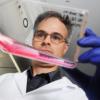", ereg_replace("
", " ", "
| Link: | http://www.eurekaler...h-ros111403.php |
| Date: | 11-16-03 |
| Author: | Amy Hoskins -br- amy@womens-health.org -br- 202-496-5011 |
| Source: | Society for Women's Health Research |
| Title: | Research on spleen cells could yield potential cure for Type 1 diabetes |
Research on spleen cells could yield potential cure for Type 1 diabetes
Washington, D.C. -- Spleen cells may develop into insulin-producing pancreatic islet cells in adult animals, a breakthrough finding that could yield a potential cure for type 1 diabetes. Published in the Nov. 14 issue of Science, the finding stems from a study conducted by Denise Faustman, M.D., Ph.D., director of Massachusetts General Hospital (MGH) Immunobiology Laboratory and chair of the Society for Women's Health Research (SWHR) board of directors.
The finding builds on a 2001 study conducted by Faustman and a team of MGH researchers in which a treatment that cures advanced type 1 diabetes in mice was discovered. In discovering the biological mechanism behind that accomplishment, the researchers also have opened a potential new approach to replacing diseased organs and tissues using adult precursor cells.
"We have found that it is possible to rapidly regrow an adult organelle without the use of embryonic stem cells," said Faustman, the study's principal investigator. "By accomplishing effective, robust and durable regeneration of islets, this discovery opens up an entirely new approach to diabetes treatment."
Type 1 diabetes develops when the body's immune cells mistakenly attack the insulin-producing islet cells of the pancreas. As islet cells die, insulin production ceases, and blood sugar levels rise, damaging organs throughout the body. In their earlier study, Faustman's team directly attacked this process by retraining the immune system not to attack islet cells.
The researchers expected to follow that process, which eliminated the autoimmune basis of the animals' diabetes, with transplants of donor islet cells. However, they were surprised to find that most of the mice did not need the transplant: Their bodies were producing normal islet cells that were secreting insulin. [:o]
"The unanswered question from that study was whether this was an example of rescuing a few remaining islet cells in the diabetic mice or of regeneration of the insulin-secreting islets from another source," said Faustman, an associate professor of Medicine at Harvard Medical School. "We've found that islet regeneration was occurring and that cells were growing from both the recipient's own cells and from the donor cells."
###
The Society for Women's Health Research is the nation's only not-for-profit organization whose mission is to improve the health of women through research, education and advocacy. Founded in 1990, the Society brought to national attention the need for the appropriate inclusion of women in major medical research studies and the need for more information about conditions affecting women disproportionately, predominately, or differently than men. The Society advocates increased funding for research on women's health; encourages the study of sex differences that may affect the prevention, diagnosis and treatment of disease; promotes the inclusion of women in medical research studies; and informs women providers, policy makers and media about contemporary women's health issues. Visit the Society's Web site at http://www.womens-health.org for more information.












































